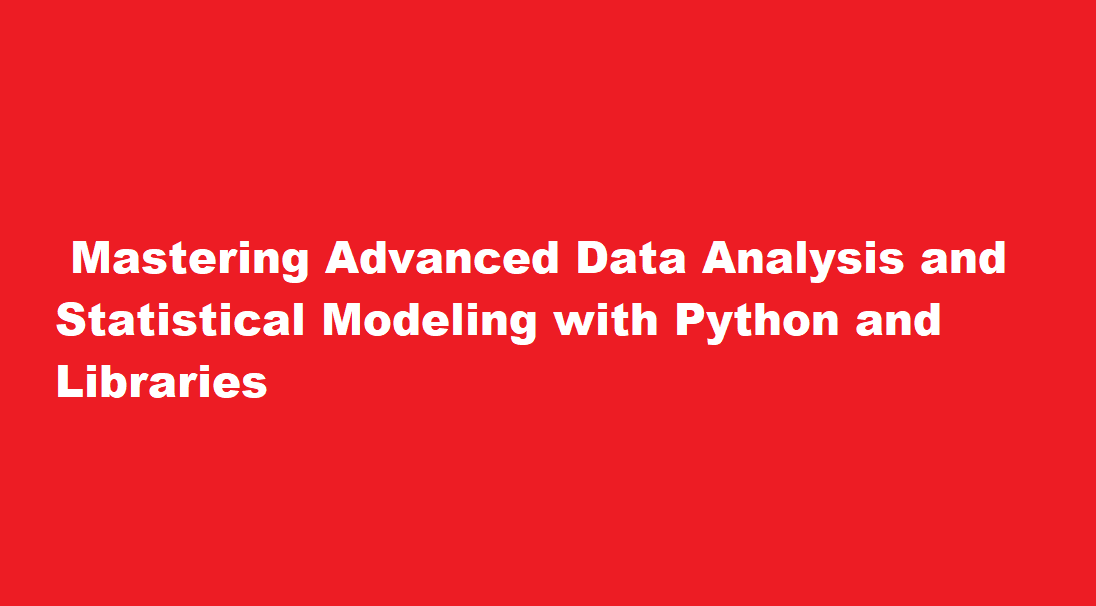Mastering Advanced Data Analysis and Statistical Modeling with Python and Libraries


In today’s data-driven world, the ability to perform advanced data analysis and statistical modeling is a crucial skill for professionals across various domains. Python, with its powerful libraries like NumPy, Pandas, and SciPy, has become the go-to choice for data scientists and analysts. In this article, we will delve into the realm of advanced data analysis and statistical modeling using Python, showcasing how these libraries can be harnessed to gain deeper insights from your data.
Understanding the Basics
Before we dive into advanced techniques, it’s essential to have a solid grasp of the basics. NumPy, short for Numerical Python, is a fundamental library for numerical operations in Python. It provides support for multi-dimensional arrays and matrices, making it an ideal choice for handling data efficiently. Pandas, on the other hand, excels in data manipulation and analysis, with its DataFrame structure providing a tabular representation of data akin to a spreadsheet.
The SciPy library complements NumPy and Pandas by offering a wide range of scientific and statistical functions, making it indispensable for advanced data analysis and modeling.
Data Preparation
The journey to advanced data analysis and statistical modeling begins with data preparation. Irrespective of your analysis goal, you must ensure that your data is clean, organized, and properly structured. NumPy and Pandas play a pivotal role in this phase.
- Data Loading Use Pandas to import data from various sources such as CSV files, Excel spreadsheets, or databases. The `read_csv()` and `read_excel()` functions are commonly employed for this purpose.
- Data Cleaning Remove missing values, duplicates, and irrelevant columns. Pandas’ `dropna()`, `drop_duplicates()`, and `drop()` methods can help in this regard.
- Data Exploration Use Pandas’ descriptive statistics functions like `describe()` and `info()` to gain a preliminary understanding of your data, including mean, standard deviation, and data types.
Advanced Data Analysis
Once your data is prepared, you can begin performing advanced data analysis using Python and the aforementioned libraries.
- Exploratory Data Analysis (EDA) EDA is a critical step in understanding your data better. Utilize Pandas for this purpose, generating summary statistics, visualizing data distributions with Matplotlib or Seaborn, and creating correlation matrices to identify relationships between variables.
- Hypothesis Testing SciPy’s `ttest_ind()`, `chi2_contingency()`, and other statistical tests help assess hypotheses and determine the significance of differences in your data.
- Feature Engineering Create new features or modify existing ones to improve model performance. Pandas’ DataFrame operations are invaluable for feature engineering tasks.
Statistical Modeling
Advanced data analysis often involves constructing statistical models to predict outcomes, classify data, or gain insights.
- Regression Analysis Employ SciPy or scikit-learn, another powerful Python library, for linear and nonlinear regression analysis. Create models to predict continuous variables using techniques like linear regression, ridge regression, or support vector regression.
- Classification If your task involves categorizing data into distinct classes, utilize scikit-learn’s classification algorithms such as decision trees, random forests, or support vector machines.
- Clustering For unsupervised learning tasks like clustering, SciPy provides functions for hierarchical clustering and K-means clustering. These techniques can uncover hidden patterns in your data.
- Time Series Analysis Pandas offers specialized tools for time series analysis, allowing you to work with temporal data efficiently. You can perform time series decomposition, forecasting, and anomaly detection.
Model Evaluation and Validation
- Cross-Validation To ensure your models generalize well to unseen data, use techniques like k-fold cross-validation, provided by scikit-learn.
- Performance Metrics Evaluate your models using appropriate metrics like accuracy, precision, recall, F1-score, and ROC-AUC, depending on the nature of your problem.
- Model Tuning Fine-tune your models by adjusting hyperparameters to optimize performance. scikit-learn provides tools like GridSearchCV and RandomizedSearchCV for this purpose.
Data Visualization and Reporting
- Data Visualization Use libraries like Matplotlib, Seaborn, or Plotly to create insightful visualizations that communicate your findings effectively.
- *Reporting Document your analysis and modeling process using Jupyter Notebooks or other reporting tools to share your insights and results with stakeholders.
FREQUENTLY ASKED QUESTIONS
Which Python library is used for statistical modeling?
NumPy and Pandas are two popular Python libraries that are often used together and provide a wide range of capabilities to support statistical modeling.
What is modeling libraries in Python?
statsmodels is a Python library for fitting many kinds of statistical models, performing statistical tests, and data exploration and visualization. statsmodels contain more “classical” frequentist statistical methods, while Bayesian methods and machine learning models are found in other libraries.
Conclusion
In this article, we’ve explored how to perform advanced data analysis and statistical modeling using Python and essential libraries like NumPy, Pandas, and SciPy. From data preparation and exploratory analysis to building sophisticated models and evaluating their performance, Python’s ecosystem provides a rich toolkit for data professionals.
To master these skills, practice is key. Work on real-world projects, participate in online courses, and continuously expand your knowledge. By harnessing the power of Python and its libraries, you’ll be well-equipped to tackle complex data analysis tasks and extract valuable insights from your data. The journey to becoming a proficient data analyst or scientist is challenging, but the rewards are immense in our data-driven world.
Read Also : Building a Fully Functional and Interactive Website from Scratch with HTML, CSS, and JavaScript
Recent Posts
A Step-by-Step Guide to Turning Off Your PS4
Introduction The PlayStation 4 (PS4) has been a gaming staple for millions of gamers worldwide…
How to Get a Receipt from Amazon – A Step-By-Step Guide
Amazon, the world's largest online retailer, offers a convenient and efficient way to shop for…
How to Leave a Group Chat on iPhone – A Step-by-Step Guide
Introduction Group chats are a fantastic way to stay connected with friends, family, or colleagues,…
A Comprehensive Guide on How to Pack a Bowl
Introduction Packing a bowl is a skill that many individuals enjoy mastering, whether for medicinal…
How to Properly Turn Off a Tesla Electric Vehicle
Introduction Tesla electric vehicles (EVs) have revolutionised the automotive industry with their cutting-edge technology and…
The Art of Capturing Majesty – A Step-by-Step Guide on How to Draw an Elephant
Introduction Drawing is a beautiful form of expression that allows us to capture the essence…


